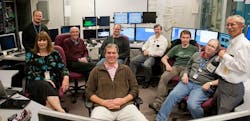Jefferson Lab laser emits high-power vacuum-ultraviolet radiation
Newport News, VA--The Thomas Jefferson National Accelerator Facility's free-electron laser (FEL) has produced vacuum-ultraviolet (VUV) light in the form of 10 eV (124 nm wavelength photons) 100 times brighter than that generated anywhere else. Vacuum-ultraviolet light is absorbed by molecules in the air, requiring the use of a vacuum for experimentation.
"Using a hole out-coupling mirror on the Jefferson Lab Ultraviolet Demonstration FEL, we delivered VUV harmonic light to a calibrated VUV photodiode and measured five nJ of fully coherent light in each micropulse," says George Neil, Jefferson Lab associate director for the FEL Division.
The feat opens the door to many lines of research that were previously inaccessible. For instance, the FEL may soon enable a method of determining the age of materials that far outstrips carbon dating. Radio-carbon dating allows scientists to estimate the age of some materials up to roughly 62,000 years. But radio-krypton dating could potentially allow scientists to determine the age of materials between 100,000 to 1 million years old. The 10 eV light from the FEL would be used to produce metastable krypton atoms for use in this dating method. The results could contribute to ocean-circulation models and maps of groundwater movement, as well as dating polar ice.
"This new laser is also a perfect tool to study novel materials with great potential for addressing issues such as energy and the environment," said Gwyn Williams, FEL basic research program manager. "We still have a lot of work ahead of us before experiments can begin. In the new year, we'll be working to deliver light into a lab for measurement and future experiments. We hope to accomplish those goals by March."
Subscribe now to Laser Focus World magazine; it’s free!
About the Author
John Wallace
Senior Technical Editor (1998-2022)
John Wallace was with Laser Focus World for nearly 25 years, retiring in late June 2022. He obtained a bachelor's degree in mechanical engineering and physics at Rutgers University and a master's in optical engineering at the University of Rochester. Before becoming an editor, John worked as an engineer at RCA, Exxon, Eastman Kodak, and GCA Corporation.

